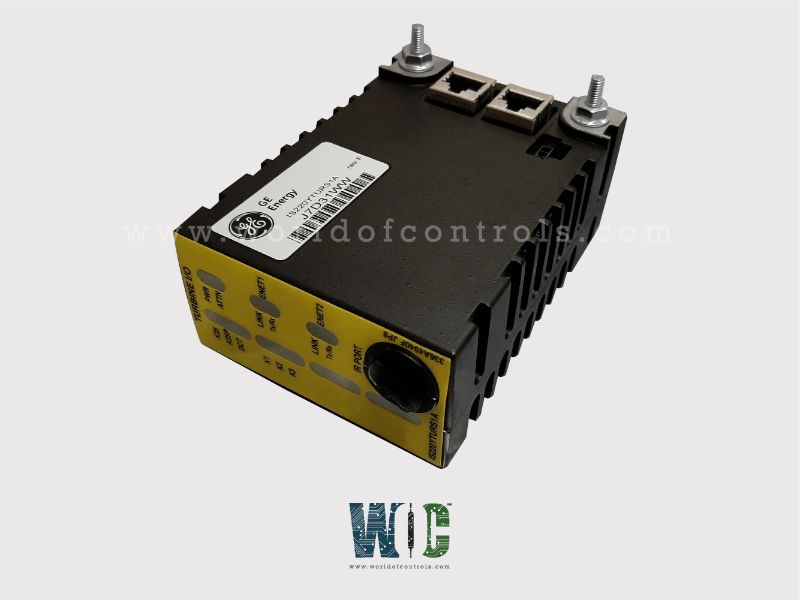SPECIFICATIONS
Part No.: IS220YTCCS1A
Manufacturer: General Electric
Series: Mark VIeS
System frequency: 50 or 60 Hz
SystemLimits: Enable, Disable
Auto Reset: Enable, Disable
ThermCplType: Unused, mV, T,K,J, E, or S
Availability: In Stock
Country of Manufacture: United States (USA)
Functional Description
IS220YTCCS1A is a Thermocouple I/O Pack developed by GE. It is a part of Mark VIeS control system. The Thermocouple Input (YTCCS1A) pack serves as a crucial intermediary, facilitating the seamless connection between one or two IONets and a terminal board. This pack, denoted as YTCC, boasts the capability to accommodate up to 12 distinct thermocouple inputs, thereby granting the flexibility required for a range of applications.
Features
- In instances where a more extensive setup is essential, the system can be scaled by employing two packs, effectively enabling the handling of up to 24 inputs through the utilization of the terminal board.
- Notably, this solution supports a diverse array of thermocouple types, namely E, J, K, S, and T, thereby accommodating a wide spectrum of temperature measurement needs. These thermocouples can be employed either in grounded or ungrounded configurations, catering to varying measurement environments and preferences. This adaptability ensures that the pack remains versatile and suited to different use cases.
- When employing the YTCC pack in conjunction with the terminal boards, compatibility is guaranteed with both the TBTC and the STTC variants. This versatility permits users to seamlessly integrate the pack into their existing setups, regardless of the terminal board's specific model.
- In scenarios demanding redundancy and heightened reliability, the pack can be configured in a Triple Modular Redundant (TMR) arrangement in conjunction with the TBTCS1B terminal board. In this specialized configuration, three packs are utilized, each featuring its own distinct cold junction. Despite the expanded redundancy provided by this arrangement, it's important to note that the number of available thermocouples is limited to 12, ensuring precise and accurate measurements.
Thermocouples
- The system offers the flexibility to choose the desired unit of measurement, either Celsius (°C) or Fahrenheit (°F), for displaying thermocouple values. It is crucial to ensure that this selected unit matches the units of the attached variable, ensuring coherence in data representation. The parameter responsible for governing this unit selection is termed ThermCplUnit.
- It's important to note that the influence of the "ThermCplUnit" parameter extends primarily to the native units utilized within the controller application variable. It has a more indirect relationship with the tray icon and its associated ability to toggle units in the Human Machine Interface (HMI). It's worth clarifying that this parameter should not be employed to alter the display units within the HMI itself.
- A word of caution is necessary when considering adjustments to the "ThermCplUnit" parameter. Changing this parameter holds the potential to trigger a cascade of consequences, necessitating corresponding alterations to the application code as well as adjustments to Format Specifications or the units employed within the connected variable. It is a modification that reaches beyond superficial adjustments and delves into the core mechanics of the system.
- This parameter's influence extends beyond mere data representation. It directly alters the actual values transmitted to the controller, thus impacting the interpretation of data within the application code. Any application code programmed to anticipate values in degrees Fahrenheit will encounter discrepancies and functional issues if this parameter is altered without due consideration.
- Furthermore, the ramifications are not solely confined to the internal workings of the system. External devices, including Human Machine Interfaces (HMIs) and Historians, are also prone to being influenced by modifications to the ThermCplUnit parameter. This interconnectedness underscores the complexity of the change and highlights the need for thorough testing and careful consideration before making any adjustments.
World of Controls has the most comprehensive collection of GE Mark VIeS components. Please contact WOC as soon as possible if you require any extra information.
Frequently Asked Questions
What is IS220YTCCS1A?
It is a Thermocouple I/O Pack developed by GE
What is SysLim2Enabl?
SysLim2Enabl is a parameter that allows you to enable or disable the system limit 2 fault check. This feature establishes a temperature limit that can be used to trigger an alarm or alert within a system.
How can I configure the SysLim2Enabl parameter?
You can set the parameter to either Enable or Disable. Enabling it activates the system limit 2 fault check, while disabling it turns off this feature.
What is the purpose of the SysLim2Latch parameter?
The parameter determines whether the limit condition established by system limit 2 will latch or unlatch. Latching means that once the limit condition is met, it will remain triggered until manually reset. Unlatching, on the other hand, means that the limit condition will reset automatically when the temperature returns to a safe range.
How can I set up the SysLim2Latch?
The SysLim2Latch can usually be configured to either Latch or Unlatch. If set to Latch, the system limit 2 fault will remain active until a manual reset is initiated. If set to Unlatch, the system limit 2 fault will reset automatically when the temperature returns to a safe level.
